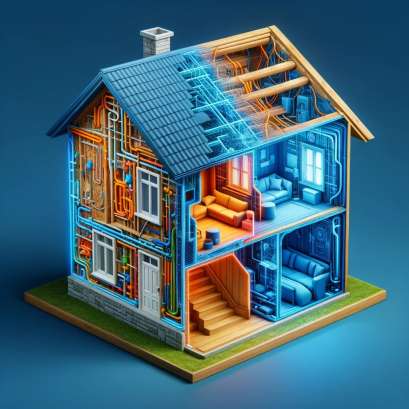Benefits of Thermal Imaging in Home Inspections: Advanced Detection for Hidden Issues
Thermal imaging technology has revolutionized the way professional inspectors evaluate properties. This sophisticated technology allows experts to identify potential problems invisible to the naked eye, providing a deeper understanding of a property’s condition without invasive testing or disruption to the structure.
Modern infrared cameras detect subtle temperature variations across surfaces, revealing hidden issues that might otherwise go unnoticed until they cause significant damage. At Singh Home Services, we employ state-of-the-art thermal imaging equipment to provide comprehensive property assessments that protect your investment.
Detecting Hidden Moisture Problems
Infrared technology excels at identifying moisture intrusion before visible damage appears. The thermal camera detects temperature differences caused by water infiltration, helping locate:
Water penetration through foundation walls often remains hidden until substantial damage occurs. Thermal scanning can reveal these moisture patterns early, allowing for preventive measures before structural issues develop. The technology detects temperature variations caused by water absorption in building materials, pinpointing problem areas that require immediate attention.
Cool spots on walls and ceilings often indicate water intrusion or leaky pipes concealed within building structures. Early detection through thermal assessment prevents extensive damage to insulation, drywall, and wooden structures. This technology proves particularly valuable in identifying potential mold-prone areas before visible signs appear.
Identifying Electrical System Issues
Thermal detection provides crucial insights into electrical system performance. The technology reveals:
Overheating electrical components emit distinct heat signatures that thermal cameras can detect. This capability allows for early identification of potential fire hazards, overloaded circuits, and failing equipment. Regular thermal assessment of electrical panels and connections helps prevent system failures and reduces fire risks.
Faulty connections and overloaded circuits generate excess heat before visible signs appear. Infrared scanning can locate these hot spots, enabling preventive maintenance before failures occur. This proactive approach to electrical system evaluation enhances safety and prevents unexpected outages.
Evaluating Insulation Effectiveness
Advanced thermal assessment reveals insulation deficiencies that impact energy efficiency:
Temperature patterns across walls and ceilings indicate areas of missing or compressed insulation. These thermal variations help identify opportunities for energy efficiency improvements and comfort enhancement. Precise detection of insulation gaps allows for targeted repairs rather than extensive replacement.
Air leakage patterns become visible through thermal imaging, revealing gaps in the building envelope that waste energy. This technology helps pinpoint specific areas requiring air sealing, improving overall building performance and reducing energy costs.
HVAC System Performance Analysis
Thermal technology provides valuable insights into heating and cooling system operation:
Temperature patterns reveal ductwork leaks and insulation failures that compromise system efficiency. Thermal assessment helps optimize HVAC performance by identifying specific areas requiring maintenance or repair. The technology also reveals patterns of heat loss or gain that affect system operation.
Infrared scanning detects irregular temperature distributions that indicate airflow problems or equipment issues. This capability allows for precise diagnosis of system inefficiencies and targeted solutions to improve performance.
Roofing System Evaluation
Thermal assessment proves invaluable for examining roof integrity:
Evening scans reveal heat retained in compromised roofing materials, indicating potential water infiltration points. This non-invasive evaluation method helps locate problematic areas before leaks develop into major issues. The technology detects trapped moisture beneath roofing materials that could lead to deterioration.
Temperature variations across roof surfaces often indicate insulation problems or developing leaks. Early detection through thermal imaging allows for targeted repairs, extending roof life and preventing interior damage.
Foundation Assessment
Advanced thermal technology aids in foundation evaluation:
Temperature differences reveal potential water infiltration points around foundation walls. This early detection capability helps prevent serious structural issues through timely intervention. The technology identifies areas where moisture penetration might compromise foundation integrity.
Thermal patterns indicate areas of heat loss through foundation walls, helping optimize basement insulation strategies. This information proves valuable for improving energy efficiency and comfort in below-grade spaces.
Investment Protection Through Technology
Contact Singh Home Services at 403-861-7100 to schedule your comprehensive property evaluation using advanced thermal imaging technology. Our certified professionals combine technical expertise with state-of-the-art equipment to provide detailed insights into your property’s condition. Visit singhhomeinspections.ca to learn more about our innovative assessment services and how they protect your investment.



